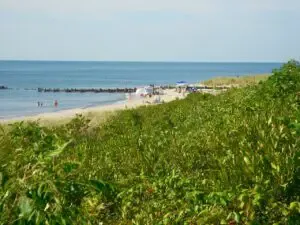Over the course of the past 10 years, more and more ice fishing devotees have been kindled with a burning passion for Kokanee salmon. Angling communities from the Pacific Northwest well into British Columbia have been stricken with the “Kokanee Craze.” In fact, Kokanee salmon is the second most popular game fish in these regions, second only to the effervescent rainbow trout. Why the enchantment with these smaller-sized salmon? They are bountiful in numbers, fun to catch and remarkable in flavor.
The very act of ice fishing for Kokanee salmon can often seem to be a massive undertaking to novice anglers. Yet, with key knowledge of a few fundamental techniques and a general understanding of Kokanee’s behavior, anyone can enjoy ice fishing for these flavorful fish. Too often, an angler’s biggest mistake is pursuing these salmon as one would a rainbow trout. While there are harmonies between these two popular fish, the behavior and nature of a Kokanee make the experience vastly different.
Today we’ll prove just how accessible fishing for Kokanee salmon can be. With the right gear and some simple lures, you’ll be ice fishing for these coveted fish in no time.
Finding Kokanee Salmon
Skilled ice fishers know where and when to find a rainbow trout or similar types of fish. To many anglers, doing so is second nature. Fishing for Kokanee salmon is quite different. You’re going to need to do things a bit differently. For example, when fishing for rainbow trout, you tend to stick to the shallows or drop off points to produce the highest yield. This is totally ineffective when fishing for Kokanee salmon.
The reason? Much of the year, especially in the winter months, Kokanee salmon feed on zooplankton for nourishment. Zooplankton tends to thrive in much deeper waters, forcing the Kokanee to go deep in order to feed. This means you’re going to want to set up at a spot that is between 30 and 80 feet deep to garner the most success. Still, even with that in mind, Kokanee salmon can prove a tough find.
Unlike other species of fish, Kokanee will move around as a school of fish rather than on their own. The hardest part of catching them is finding them in the first place. This can be disparaging to some anglers, especially those who have never sought Kokanee salmon. While they aren’t easy to find, once you can locate a school of Kokanee, things get much easier.
In fact, once located, it is nearly impossible to keep them from biting. So how can you even go about locating a Kokanee salmon school? Well, you may want to utilize a fish finder. If not, strive to drill several holes spread out over the ice. Start at one and then move on if you don’t notice any activity for over 15 minutes. Move from hole to hole until you find some action. Start around 30 feet of depth and drop down more if you struggle to locate the fish.
Eventually, you’ll locate the school and experience all of the fruits of your labor.
How to Fish for Kokanee Salmon
Knowing where to find Kokanee salmon is just one piece of a very elaborate puzzle. Location matters, but putting key methods to practice might matter even more. To fish for Kokanee salmon, start by drilling several different holes. As mentioned above, this can be paramount in helping to locate the actual school of fish. Generally, go with a depth of 30 feet to start. If you don’t find success with one hole, move to another and then another, adjusting your depth along the way. Eventually, you’ll locate the school.
In terms of method, our experience has shown that ice fishing for kokanees salmon works best with a jigging technique. To utilize jigging, drop a lure straight down and slowly lift and lower your rod. You may have to repeat the process several times. It is really that simple. Just ensure that you’re doing the action in a slow and smooth motion. Avoid being too jerky or fast, as that can spook the school.
Try jigging for a few minutes at a depth of 30 feet. If you’re still not getting any bites, go down lower in 10 feet increments. Keep lowering your reel until you’re 80 feet. If you’re still not getting any attention, try a different hole.
The Best Lures for Kokanee Salmon Ice Fishing
As mentioned above, ice fishing for Kokanee salmon is quite different than ice fishing for rainbow trout or a more common species of fish. This means you’ll need to employ distinct lures in order to make the most impact. There are several disparate lures you can take advantage of to catch Kokanee. Most of the time, light lures work best, but certainly different anglers experience different types of success with each lure.
Many ice fishers notice that glow-lure hooks work well once you’ve detected a school of Kokanee. Just as the name implies, these hooks glisten in the water and prove an impressive attractant for fish. Useful hues include shades of red, white, or pink. With any Kokanee lure, aim to include some light-pink maggot pieces to the ends. Another type of lure that works well are light glow jigs since they best imitate zooplankton.
Ice Fishing Gear for Kokanee Salmon
Do you really need distinctive ice fishing gear when it comes to Kokanee?and The jury is out, but most anglers agree that there are some gear adjustments you’ll need to keep in mind. To start, you’re going to need the appropriate rod. Opt for an agile lightweight rod so you can more easily feel the tug of a fish. Since Kokanee aren’t very huge in size, a slighter rod allows you to sense the actual bite. In terms of fishing line, we recommend a line that is geared for 10 lbs, braided, and includes a monofilament.
Anglers also have the option of employing an ice braid and then attaching a leader of at least 2-feet. The key to really getting Kokanee to nibble is to attach a flasher to whatever line you choose. What is the point of a flasher? In theory, these draw the fish right to your line. Since Kokanee are already so arduous to entice, having the right flasher can be paramount in expediting the process. Opt for a flasher that is just below 5- inches long. Red and silver hues work best.
Key Tips for Kokanee Ice Fishing Success
Want to really make the most out of ice fishing for kokanee salmon? We’ve developed a few key tips to help you make the most of your outing.
Be sure to read our article highlighting the Best Time of Day to Go Ice Fishing.
Procure a Fish Finder
As previously stated, Kokanee salmon like to go deep. Often as deep as 80 feet. Since these salmon love to feed on zooplankton in deep water columns, finding them is like ascertaining that coveted needle in a haystack. Thankfully, Kokanee almost always travels in a school. Once you know where the school is located, you’ll be guaranteed to land more than a few. While you can do this by drilling several holes and testing your luck, you can also purchase a fish finder to figure out how deep the water is in a given area and where the Kokanee salmon are hunkering down.
Use the Jigging Method
We really want to touch on the jigging method once more because it is often the most effective method of ice fishing for kokanee salmon. Kokanee salmon are naturally quite curious. A jigging line will bring them over and help you to land a big catch. You just want to make sure to jig in a smooth motion. Just as Kokanee are curious, they are quite skittish. Being too jarring in your methods can spook the entire school, thwarting even your best-laid plans.
Take Advantage of Attractors
Seriously, an attractor is going to be your best friend when ice fishing for Kokanee. Since Kokanee are so inquisitive, employing a wide spoon can quickly entice them into your area. All you have to do is tie a tough, hookless spoon to your line,(strive for 3-5 inches) and then take a smaller baited hook and secure that to the spoon with a monofilament leader. Just like that, you’ll be attracting all of the fish.
Follow Safety Practices
Ice fishing is rather safe, but there are always precautions to keep in mind when fishing. Repeatedly make sure that any ice you’re settling on is at l4-5 inches thick you’re going solo. When fishing with others, the ice should be a minimum of 12 inches thick. Before treading the ice, lob a few sizable rocks out into the area you intend to fish upon. If the rocks shatter the ice, stay away. If the rocks don’t make a difference, gently walk out and form a test hole. Plant something into the hole to certify diameter before going any further.
The Bottom Line
Ice fishing for Kokanee salmon can prove a challenging experience, yet is often one of the most rewarding types of fishing for new and experienced anglers. Once you get the hang of locating schools of Kokanee salmon and attracting them via various lures and methods, you’ll find that there is no sweeter moment than reeling in a big catch. Let’s not even get started on how succulent and exceptional these fish taste after all that hard work.
Follow Kokanee salmon best practices, use light gear, and get a fish finder if you’d like to make the experience a bit easier. Overall, pulling in a big yield doesn’t have to be frustrating.



